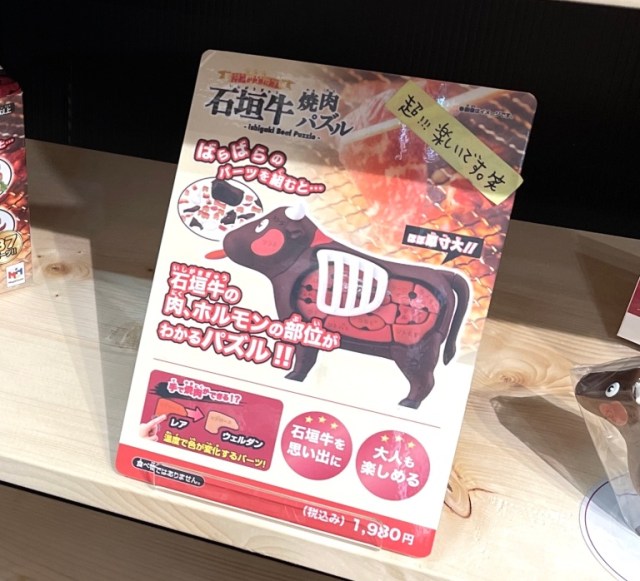
Can’t tell your sotomomo from your sankakubara? This puzzle is here to help!
Yakiniku seems like it should be the easiest thing in the world to order. It’s all just strips of beef, which you cook yourself on the in-table grill, right?
Sure, but it’s not like the restaurant just gives you a random assortment of beef slices. Instead, you order specific cuts of beef, so in order to get what you want you need to know what part of the cow each cut comes from, and also what they’re called in Japanese.
So today, we’re brushing up on our yakiniku vocabulary with the help of this cute and quirky 3-D puzzle we picked up on Ishigakijima Island in Okinawa.
Called the Ishigaki Beef Puzzle, it set us back 1,980 yen (US$17.20), but we figured that’s a worthwhile investment if it leads to more delicious yakiniku meals in our future.
Each meat piece has its name written on it in phonetic katakana Japanese text, so let’s start off by listing them and their English equivalents.
From left to right, starting with the top row and then moving down, those are:
1. kata rosu / カタロース: shoulder roast
2. maebara / マエバラ: chuck roast
3. ribu rosu / リブロース: ribeye roast
4. hire / ヒレ: tenderloin
5. nekku / ネック: neck
6. saroin / サーロイン: sirloin
7. nakabara ナカバラ: boneless short rib (also sometimes called jokarubu / 上カルビ)
8. ranpu, ichibo / ランプ, イチボ: upper rump, lower rump
9. ude / ウデ: shoulder clod
10. sankakubara / サンカクバラ: chuck short ribs
11. karubi / カルビ: boneless short rib (situated lower nakabara)
12. sotobara / ソトバラ: short plate
13. maru, uchimomo / マル, ウチモモ: round, top round
14. sotomomo / ソトモモ: bottom round
As we started to put the pieces together, we quickly learned that this puzzle is incredibly difficult, and not just because the pieces are tiny.
The bigger problem than the small pieces is that unlike with, say, a jigsaw puzzle, the Ishigaki Beef Puzzle’s packaging doesn’t have picture of the completed puzzle. So while we had the outer cow put together quickly, we were pretty lost on what to do next.
▼ We know this should be filled with meat. We’re just not sure how.
Some of the cuts’ names, though, are hints in and of themselves. Nakabara, for example, literally means “inner belly,” so it makes sense that it goes at the very center. And with sotobara translating directly as “outer belly,” we figured that would be somewhere closer to the bottom of the cow. Eventually, with the help of a little online research, we were able to get everything in place, and it looked like this.
Loosely grouped into three rows, from left to right those are:
●Top row: kata rosu, ribu rosu, hire, ranpu, ichibo
● Middle row: maebara, sankakubara, nakabara, maru, uchimomo
● Bottom row: ude, sotobara, karubi, sotomomo
Once you know what the cut you want is called, ordering it in a restaurant is as easy as saying “kudasai” (“please”) after the cut’s name.
Oh, and since this is a yakiniku puzzle, you’re supposed to “cook” the assembled version to your liking using a hair dryer, with the pieces turning from raw-red to pseudo-grilled brown as they heat.
By the way, you may have noticed that the box says the puzzle actually has 37 parts. In addition to the cuts of meat, there are a few incidentals like the cow’s tongue and rib bones…
…but there’s also a complete set of horumon, organs and other non-meat parts of the cow that are also offered at yakiniku restaurants, that go underneath the puzzle’s meat cuts.
But if you’ll excuse us, all this playing with food toys has us feeling very hungry, and now that we know what each cut of beef is called, we feel the need to run full-speed to our nearest yakiniku restaurant.
Photos ©SoraNews24
● Want to hear about SoraNews24’s latest articles as soon as they’re published? Follow us on Facebook and Twitter!
[ Read in Japanese ]